Electric light
An electric light, lamp, or light bulb is an electrical component that produces light. It is the most common form of artificial lighting. Lamps usually have a base made of ceramic, metal, glass, or plastic, which secures the lamp in the socket of a light fixture, which is often called a "lamp" as well. The electrical connection to the socket may be made with a screw-thread base, two metal pins, two metal caps or a bayonet cap.
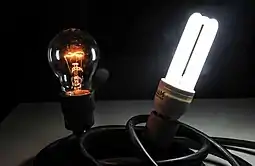 Incandescent and compact fluorescent lamp turned on | |
| Type | Depends on type of light |
|---|---|
| Working principle | Luminescence by electricity |
| Invented | Humphry Davy (1809, arc lamp) |
| First production | Joseph Swan and Thomas Edison (first demo of incandescent bulb in 1879) |
| Pin configuration | Anode and cathode |
| Electronic symbol | |
The three main categories of electric lights are incandescent lamps, which produce light by a filament heated white-hot by electric current, gas-discharge lamps, which produce light by means of an electric arc through a gas, such as fluorescent lamps, and LED lamps, which produce light by a flow of electrons across a band gap in a semiconductor.
Before electric lighting became common in the early 20th century, people used candles, gas lights, oil lamps, and fires.[1] Vasily Vladimirovich Petrov developed the first persistent electric arc in 1802, and English chemist Humphry Davy gave a practical demonstration of an arc light in 1806. By the 1870s, Davy's arc lamp had been successfully commercialized, and was used to light many public spaces.[2] Efforts by Joseph Swan and Thomas Edison led to commercial incandescent light bulbs becoming widely available in the 1880s, and by the early twentieth century these had completely replaced arc lamps.[3][1]
The energy efficiency of electric lighting has increased radically since the first demonstration of arc lamps and the incandescent light bulb of the 19th century. Modern electric light sources come in a profusion of types and sizes adapted to many applications. Most modern electric lighting is powered by centrally generated electric power, but lighting may also be powered by mobile or standby electric generators or battery systems. Battery-powered light is often reserved for when and where stationary lights fail, often in the form of flashlights or electric lanterns, as well as in vehicles.
Types
Incandescent

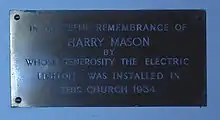
While the ability of wires to illuminate when supplied with current was first discovered during the Enlightenment, it took more than a century of continuous and incremental improvement, including numerous designs, patents, and resulting intellectual property disputes, until incandescent light bulbs became commercially available in the 1920s.[4][5]
In its modern form, the incandescent light bulb consists of a coiled filament of tungsten sealed in a globular glass chamber, either a vacuum or full of an inert gas such as argon. When an electric current is connected, the tungsten is heated to 2,000 to 3,300 K (1,730 to 3,030 °C; 3,140 to 5,480 °F) and glows, emitting light that approximates a continuous spectrum.
Incandescent bulbs are highly inefficient, in that just 2-5% of the energy consumed is emitted as visible, usable light. The remaining 95% is lost as heat.[6] In warmer climates, the emitted heat must then be removed, putting additional pressure on ventilation or air conditioning systems.[7] In colder weather, the heat byproduct has some value, and has been successfully harnessed for warming in devices such as heat lamps. Incandescent bulbs are nonetheless being phased out in favor of technologies like CFLs and LED bulbs in many countries due to their low energy efficiency. The European Commission estimated in 2012 that a complete ban on incandescent bulbs would contribute 5 to 10 billion euros to the economy and save 15 billion metric tonnes of carbon dioxide emissions.[8]
Halogen
Halogen lamps are usually much smaller than standard incandescent lamps, because for successful operation a bulb temperature over 200 °C is generally necessary. For this reason, most have a bulb of fused silica (quartz) or aluminosilicate glass. This is often sealed inside an additional layer of glass. The outer glass is a safety precaution, to reduce ultraviolet emission and to contain hot glass shards should the inner envelope explode during operation. Oily residue from fingerprints may cause a hot quartz envelope to shatter due to excessive heat buildup at the contamination site. The risk of burns or fire is also greater with bare bulbs, leading to their prohibition in some places, unless enclosed by the luminaire.
Those designed for 12- or 24-volt operation have compact filaments, useful for good optical control. Also, they have higher efficacies (lumens per watt) and better lives than non-halogen types. The light output remains almost constant throughout their life.
Fluorescent

Fluorescent lamps consist of a glass tube that contains mercury vapour or argon under low pressure. Electricity flowing through the tube causes the gases to give off ultraviolet energy. The inside of the tubes are coated with phosphors that give off visible light when struck by ultraviolet photons.[9] They have much higher efficiency than incandescent lamps. For the same amount of light generated, they typically use around one-quarter to one-third the power of an incandescent. The typical luminous efficacy of fluorescent lighting systems is 50–100 lumens per watt, several times the efficacy of incandescent bulbs with comparable light output. Fluorescent lamp fixtures are more costly than incandescent lamps, because they require a ballast to regulate the current through the lamp, but the lower energy cost typically offsets the higher initial cost. Compact fluorescent lamps are available in the same popular sizes as incandescent lamps and are used as an energy-saving alternative in homes. Because they contain mercury, many fluorescent lamps are classified as hazardous waste. The United States Environmental Protection Agency recommends that fluorescent lamps be segregated from general waste for recycling or safe disposal, and some jurisdictions require recycling of them.[10]
LED
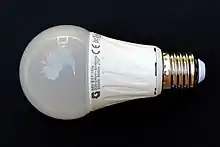
The solid-state light-emitting diode (LED) has been popular as an indicator light in consumer electronics and professional audio gear since the 1970s. In the 2000s, efficacy and output have risen to the point where LEDs are now being used in lighting applications such as car headlights and brake lights, in flashlights and bicycle lights, as well as in decorative applications, such as holiday lighting. Indicator LEDs are known for their extremely long life, up to 100,000 hours, but lighting LEDs are operated much less conservatively, and consequently have shorter lives. LED technology is useful for lighting designers, because of its low power consumption, low heat generation, instantaneous on/off control, and in the case of single color LEDs, continuity of color throughout the life of the diode and relatively low cost of manufacture. LED lifetime depends strongly on the temperature of the diode. Operating an LED lamp in conditions that increase the internal temperature can greatly shorten the lamp's life.
Carbon arc
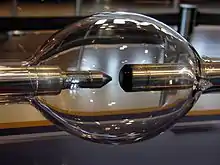
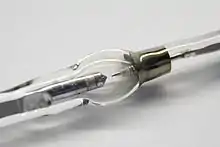
Carbon arc lamps consist of two carbon rod electrodes in open air, supplied by a current-limiting ballast. The electric arc is struck by touching the rod tips then separating them. The ensuing arc produces a white-hot plasma between the rod tips. These lamps have higher efficacy than filament lamps, but the carbon rods are short-lived and require constant adjustment in use, as the intense heat of the arc erodes them.[11] The lamps produce significant ultraviolet output, they require ventilation when used indoors, and due to their intensity they need protection from direct sight.
Invented by Humphry Davy around 1805, the carbon arc was the first practical electric light. It was used commercially beginning in the 1870s for large building and street lighting until it was superseded in the early 20th century by the incandescent light. Carbon arc lamps operate at high power and produce high intensity white light. They also are a point source of light. They remained in use in limited applications that required these properties, such as movie projectors, stage lighting, and searchlights, until after World War II.[11]
Discharge
A discharge lamp has a glass or silica envelope containing two metal electrodes separated by a gas. Gases used include, neon, argon, xenon, sodium, metal halide, and mercury. The core operating principle is much the same as the carbon arc lamp, but the term "arc lamp" normally refers to carbon arc lamps, with more modern types of gas discharge lamp normally called discharge lamps. With some discharge lamps, very high voltage is used to strike the arc. This requires an electrical circuit called an igniter, which is part of the electrical ballast circuitry. After the arc is struck, the internal resistance of the lamp drops to a low level, and the ballast limits the current to the operating current. Without a ballast, excess current would flow, causing rapid destruction of the lamp.
Some lamp types contain a small amount of neon, which permits striking at normal running voltage with no external ignition circuitry. Low-pressure sodium lamps operate this way. The simplest ballasts are just an inductor, and are chosen where cost is the deciding factor, such as street lighting. More advanced electronic ballasts may be designed to maintain constant light output over the life of the lamp, may drive the lamp with a square wave to maintain completely flicker-free output, and shut down in the event of certain faults.
The most efficient source of electric light is the low-pressure sodium lamp. It produces, for all practical purposes, a monochromatic orange-yellow light, which gives a similarly monochromatic perception of any illuminated scene. For this reason, it is generally reserved for outdoor public lighting applications. Low-pressure sodium lights are favoured for public lighting by astronomers, since the light pollution that they generate can be easily filtered, contrary to broadband or continuous spectra.
Form factor
Many lamp units, or light bulbs, are specified in standardized shape codes and socket names. Incandescent bulbs and their retrofit replacements are often specified as "A19/A60 E26/E27", a common size for these kind of light bulbs. In this example, the "A" parameters describe the bulb size and shape within the A-series light bulb while the "E" parameters describe the Edison screw base size and thread characteristics.[12]
Life expectancy
Life expectancy for many types of lamp is defined as the number of hours of operation at which 50% of them fail, that is the median life of the lamps. Production tolerances as low as 1% can create a variance of 25% in lamp life, so in general some lamps will fail well before the rated life expectancy, and some will last much longer. For LEDs, lamp life is defined as the operation time at which 50% of lamps have experienced a 70% decrease in light output. In the 1900s the Phoebus cartel formed in an attempt to reduce the life of electric light bulbs, an example of planned obsolescence.[13][14]
Some types of lamp are also sensitive to switching cycles. Rooms with frequent switching, such as bathrooms, can expect much shorter lamp life than what is printed on the box. Compact fluorescent lamps are particularly sensitive to switching cycles.
Uses
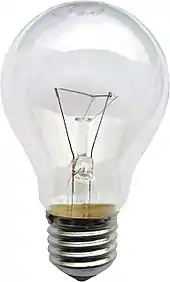
The total amount of artificial light (especially from street light) is sufficient for cities to be easily visible at night from the air, and from space. External lighting grew at a rate of 3-6 percent for the later half of the 20th century and is the major source of light pollution[15] that burdens astronomers[16] and others with 80% of the world's population living in areas with night time light pollution.[17] Light pollution has been shown to have a negative effect on some wildlife.[15][18]
Electric lamps can be used as heat sources, for example in incubators, as infrared lamps in fast food restaurants and toys such as the Kenner Easy-Bake Oven.[19]
Lamps can also be used for light therapy to deal with such issues as vitamin D deficiency,[20] skin conditions such as acne[21][22] and dermatitis,[23] skin cancers,[24] and seasonal affective disorder.[25][26][27] Lamps which emit a specific frequency of blue light are also used to treat neonatal jaundice[28] with the treatment which was initially undertaken in hospitals being able to be conducted at home.[29][30]
Electric lamps can also be used as a grow light to aid in plant growth[31] especially in indoor hydroponics and aquatic plants with recent research into the most effective types of light for plant growth.[32]
Due to their nonlinear resistance characteristics, tungsten filament lamps have long been used as fast-acting thermistors in electronic circuits. Popular uses have included:
- Stabilization of sine wave oscillators
- Protection of tweeters in loudspeaker enclosures; excess current that is too high for the tweeter illuminates the light rather than destroying the tweeter.
- Automatic volume control in telephones
A stylized depiction of a light bulb features as the logo of the Turkish AK Party.[33][34]
Circuit symbols
In circuit diagrams, lamps have two main types of symbols, indicating their respective functions. These are:
 The cross in a circle usually represents a lamp as an indicator. (ANSI/IEEE Std 315A-1986)
The cross in a circle usually represents a lamp as an indicator. (ANSI/IEEE Std 315A-1986) The semicircular dent in a circle, which usually represents a lamp as a source of light or illumination.
The semicircular dent in a circle, which usually represents a lamp as a source of light or illumination.
Cultural symbolism
In Western culture, a lightbulb — in particular, the appearance of an illuminated lightbulb above a person's head — signifies sudden inspiration.
See also
- Light tube
- List of light sources
- Flameless candle
References
- Freebert, Ernest (2014). The Age of Edison: Electric Light and the Invention of Modern America. Penguin Books. ISBN 978-0-14-312444-3.
- Guarnieri, M. (2015). "Switching the Light: From Chemical to Electrical" (PDF). IEEE Industrial Electronics Magazine. 9 (3): 44–47. doi:10.1109/MIE.2015.2454038. hdl:11577/3164116. S2CID 2986686. Archived (PDF) from the original on 2022-02-14. Retrieved 2019-09-02.
- Reisert, Sarah (2015). "Let There be Light". Distillations Magazine. 1 (3): 44–45. Archived from the original on 22 March 2018. Retrieved 22 March 2018.
- Blake-Coleman, B. C. (Barrie Charles) (1992). Copper Wire and Electrical Conductors – The Shaping of a Technology. Harwood Academic Publishers. p. 127. ISBN 3-7186-5200-5. Archived from the original on 6 December 2017.
- "The History of the Light Bulb". Energy.gov. U.S. Department of Energy. Archived from the original on 20 August 2022. Retrieved 19 August 2022.
- "High Efficiency Incandescent Lighting | MIT Technology Licensing Office". tlo.mit.edu. Archived from the original on 19 August 2022. Retrieved 19 August 2022.
- "6 Ways to Save Money on Your Air Conditioning Bill". NOPEC. Archived from the original on 19 August 2022. Retrieved 19 August 2022.
- "Frequently asked questions about the regulation on ecodesign requirements for non-directional household lamps". European Commission - European Commission. Archived from the original on 19 August 2022. Retrieved 19 August 2022.
- Perkowitz, Sidney; Henry, A. Joseph (23 November 1998). Empire of Light:: A History of Discovery in Science and Art. Joseph Henry Press. ISBN 978-0-309-06556-6. Archived from the original on 20 October 2021. Retrieved 10 November 2020.
- United States Environmental Protection Agency, OSWER (2015-07-23). "Hazardous Waste". US EPA. Archived from the original on 2015-06-29. Retrieved 3 November 2018.
- Center, Edison Tech. "Arc Lamps - How They Work & History". www.edisontechcenter.org. Archived from the original on 2017-06-17. Retrieved 2018-01-13.
- "Light Bulb Sizes, Shapes and Temperatures Charts - Bulb Reference Guide". www.superiorlighting.com. Retrieved 2022-10-07.
- MacKinnon, J. B. (2016-07-14). "The L.E.D. Quandary: Why There's No Such Thing as "Built to Last"". The New Yorker. ISSN 0028-792X. Archived from the original on 2017-11-14. Retrieved 2017-11-05.
- "The Great Lightbulb Conspiracy". IEEE Spectrum. 2014-09-24. Retrieved 2022-10-07.
- "Artificial lights are eating away at dark nights — and that's not a good thing". Los Angeles Times. 2017-11-22. Retrieved 2022-10-07.
- "Light Pollution". sites.astro.caltech.edu. Retrieved 2022-10-07.
- Falchi, Fabio; Cinzano, Pierantonio; Duriscoe, Dan; Kyba, Christopher C. M.; Elvidge, Christopher D.; Baugh, Kimberly; Portnov, Boris A.; Rybnikova, Nataliya A.; Furgoni, Riccardo (2016-06-10). "The new world atlas of artificial night sky brightness". Science Advances. 2 (6): e1600377. doi:10.1126/sciadv.1600377. ISSN 2375-2548. PMC 4928945. PMID 27386582.
- Pain, Stephanie (2018-03-23). "There goes the night". Knowable Magazine | Annual Reviews. doi:10.1146/knowable-032218-043601.
- "Easy-Bake Oven". The Strong National Museum of Play. Retrieved 2022-10-07.
- Lee, Ernest; Koo, John; Berger, Tim (May 2005). "UVB phototherapy and skin cancer risk: a review of the literature". International Journal of Dermatology. 44 (5): 355–360. doi:10.1111/j.1365-4632.2004.02186.x. ISSN 0011-9059.
- Pei, Susan; Inamadar, Arun C.; Adya, Keshavmurthy A.; Tsoukas, Maria M. (May 2015). "Light-based therapies in acne treatment". Indian Dermatology Online Journal. 6 (3): 145–157. doi:10.4103/2229-5178.156379. ISSN 2229-5178. PMC 4439741. PMID 26009707.
- Hamilton, F.L.; Car, J.; Lyons, C.; Car, M.; Layton, A.; Majeed, A. (June 2009). "Laser and other light therapies for the treatment of acne vulgaris: systematic review". British Journal of Dermatology. 160 (6): 1273–1285. doi:10.1111/j.1365-2133.2009.09047.x.
- Patrizi, Annalisa; Raone, Beatrice; Ravaioli, Giulia Maria (2015-10-05). "Management of atopic dermatitis: safety and efficacy of phototherapy". Clinical, Cosmetic and Investigational Dermatology. 8: 511–520. doi:10.2147/CCID.S87987. PMC 4599569. PMID 26491366.
- Morton, C.A.; Brown, S.B.; Collins, S.; Ibbotson, S.; Jenkinson, H.; Kurwa, H.; Langmack, K.; Mckenna, K.; Moseley, H.; Pearse, A.D.; Stringer, M.; Taylor, D.K.; Wong, G.; Rhodes, L.E. (April 2002). "Guidelines for topical photodynamic therapy: report of a workshop of the British Photodermatology Group". British Journal of Dermatology. 146 (4): 552–567. doi:10.1046/j.1365-2133.2002.04719.x. ISSN 0007-0963.
- Thompson, C.; Stinson, D.; Smith, A. (1990-09-22). "Seasonal affective disorder and season-dependent abnormalities of melatonin suppression by light". The Lancet. 336 (8717): 703–706. doi:10.1016/0140-6736(90)92202-S. ISSN 0140-6736. PMID 1975891.
- Danilenko, K. V.; Ivanova, I. A. (2015-07-15). "Dawn simulation vs. bright light in seasonal affective disorder: Treatment effects and subjective preference". Journal of Affective Disorders. 180: 87–89. doi:10.1016/j.jad.2015.03.055. ISSN 0165-0327.
- Sanassi, Lorraine A. (February 2014). "Seasonal affective disorder: Is there light at the end of the tunnel?". JAAPA. 27 (2): 18–22. doi:10.1097/01.JAA.0000442698.03223.f3. ISSN 1547-1896.
- Cremer, R. J.; Perryman, P. W.; Richards, D. H. (1958-05-24). "INFLUENCE OF LIGHT ON THE HYPERBILIRUBINÆMIA OF INFANTS". The Lancet. 271 (7030): 1094–1097. doi:10.1016/S0140-6736(58)91849-X. ISSN 0140-6736.
- Anderson, Candice Megan; Kandasamy, Yogavijayan; Kilcullen, Meegan (2022-10-01). "The efficacy of home phototherapy for physiological and non-physiological neonatal jaundice: A systematic review". Journal of Neonatal Nursing. 28 (5): 312–326. doi:10.1016/j.jnn.2021.08.010. ISSN 1355-1841.
- Pettersson, M.; Eriksson, M.; Albinsson, E.; Ohlin, A. (2021-05-01). "Home phototherapy for hyperbilirubinemia in term neonates—an unblinded multicentre randomized controlled trial". European Journal of Pediatrics. 180 (5): 1603–1610. doi:10.1007/s00431-021-03932-4. ISSN 1432-1076. PMC 8032579. PMID 33469713.
- "How to Choose the Proper Grow Light for Your Indoor Garden". primalgrowgear.com. 2021-08-27. Archived from the original on 2022-01-05. Retrieved 2022-01-05.
- Terashima, Ichiro; Fujita, Takashi; Inoue, Takeshi; Chow, Wah Soon; Oguchi, Riichi (April 2009). "Green Light Drives Leaf Photosynthesis More Efficiently than Red Light in Strong White Light: Revisiting the Enigmatic Question of Why Leaves are Green". Plant and Cell Physiology. 50 (4): 684–697. doi:10.1093/pcp/pcp034. ISSN 1471-9053.
- Thomson Reuters (2013-06-29). "A protester holds a light bulb, the official symbol of Turkey's ruling AK Party (AKP), with a Nazi swastika sign painted on it during an anti-government protest at Taksim Square in Istanbul". news.trust.org. Archived from the original on 2018-11-03. Retrieved 2018-11-03.
- Kutlugun, Satuk Bugra; Akcay, Ahmet Sait (14 August 2016). "15 years of Turkey's Justice and Development Party". Anadolu Agency. Archived from the original on 30 August 2022. Retrieved 3 November 2018.